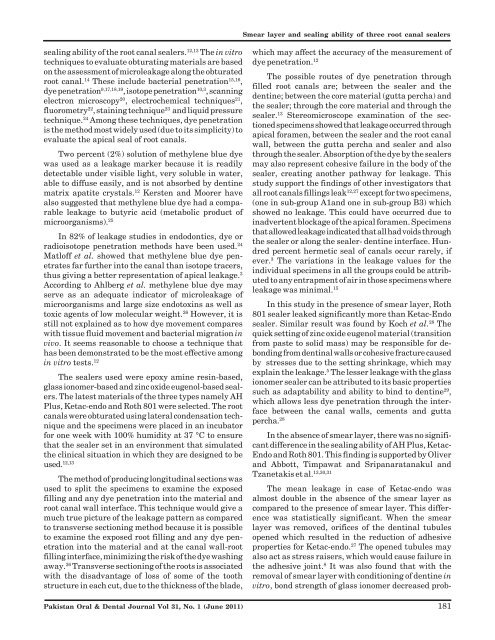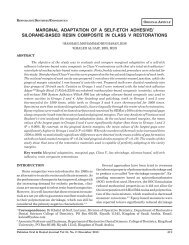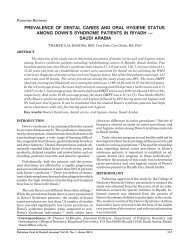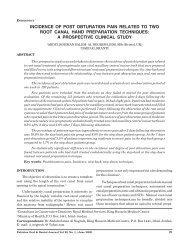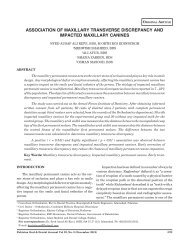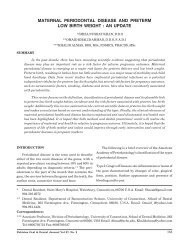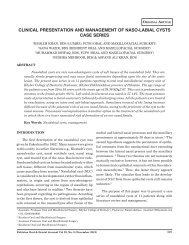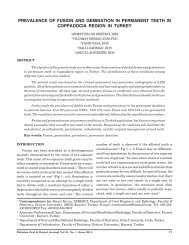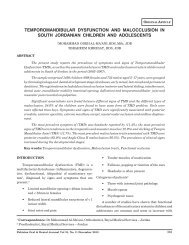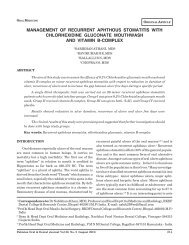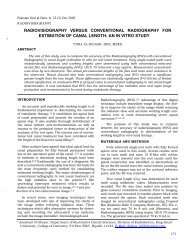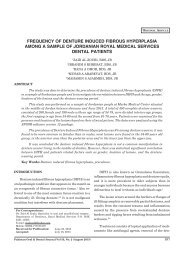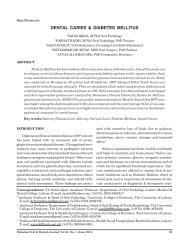<strong>Smear</strong> <strong>layer</strong> <strong>and</strong> <strong>sealing</strong> <strong>ability</strong> <strong>of</strong> <strong>three</strong> <strong>root</strong> <strong>canal</strong> <strong>sealers</strong><strong>sealing</strong> <strong>ability</strong> <strong>of</strong> the <strong>root</strong> <strong>canal</strong> <strong>sealers</strong>. 12,13 The in vitrotechniques to evaluate obturating materials are basedon the assessment <strong>of</strong> microleakage along the obturated<strong>root</strong> <strong>canal</strong>. 14 These include bacterial penetration 15,16 ,dye penetration 9,17,18,19 , isotope penetration 10,3 , scanningelectron microscopy 20 , electrochemical techniques 21 ,fluorometry 22 , staining technique 23 <strong>and</strong> liquid pressuretechnique. 24 Among these techniques, dye penetrationis the method most widely used (due to its simplicity) toevaluate the apical seal <strong>of</strong> <strong>root</strong> <strong>canal</strong>s.Two percent (2%) solution <strong>of</strong> methylene blue dyewas used as a leakage marker because it is readilydetectable under visible light, very soluble in water,able to diffuse easily, <strong>and</strong> is not absorbed by dentinematrix apatite crystals. 12 Kersten <strong>and</strong> Moorer havealso suggested that methylene blue dye had a comparableleakage to butyric acid (metabolic product <strong>of</strong>microorganisms). 25In 82% <strong>of</strong> leakage studies in endodontics, dye orradioisotope penetration methods have been used. 24Matl<strong>of</strong>f et al. showed that methylene blue dye penetratesfar further into the <strong>canal</strong> than isotope tracers,thus giving a better representation <strong>of</strong> apical leakage. 3According to Ahlberg et al. methylene blue dye mayserve as an adequate indicator <strong>of</strong> microleakage <strong>of</strong>microorganisms <strong>and</strong> large size endotoxins as well astoxic agents <strong>of</strong> low molecular weight. 26 However, it isstill not explained as to how dye movement compareswith tissue fluid movement <strong>and</strong> bacterial migration invivo. It seems reasonable to choose a technique thathas been demonstrated to be the most effective amongin vitro tests. 12The <strong>sealers</strong> used were epoxy amine resin-based,glass ionomer-based <strong>and</strong> zinc oxide eugenol-based <strong>sealers</strong>.The latest materials <strong>of</strong> the <strong>three</strong> types namely AHPlus, Ketac-endo <strong>and</strong> Roth 801 were selected. The <strong>root</strong><strong>canal</strong>s were obturated using lateral condensation technique<strong>and</strong> the specimens were placed in an incubatorfor one week with 100% humidity at 37 °C to ensurethat the sealer set in an environment that simulatedthe clinical situation in which they are designed to beused. 12,13The method <strong>of</strong> producing longitudinal sections wasused to split the specimens to examine the exposedfilling <strong>and</strong> any dye penetration into the material <strong>and</strong><strong>root</strong> <strong>canal</strong> wall interface. This technique would give amuch true picture <strong>of</strong> the leakage pattern as comparedto transverse sectioning method because it is possibleto examine the exposed <strong>root</strong> filling <strong>and</strong> any dye penetrationinto the material <strong>and</strong> at the <strong>canal</strong> wall-<strong>root</strong>filling interface, minimizing the risk <strong>of</strong> the dye washingaway. 26 Transverse sectioning <strong>of</strong> the <strong>root</strong>s is associatedwith the disadvantage <strong>of</strong> loss <strong>of</strong> some <strong>of</strong> the toothstructure in each cut, due to the thickness <strong>of</strong> the blade,Pakistan Oral & Dental Journal Vol 31, No. 1 (June 2011)which may affect the accuracy <strong>of</strong> the measurement <strong>of</strong>dye penetration. 12The possible routes <strong>of</strong> dye penetration throughfilled <strong>root</strong> <strong>canal</strong>s are; between the sealer <strong>and</strong> thedentine; between the core material (gutta percha) <strong>and</strong>the sealer; through the core material <strong>and</strong> through thesealer. 13 Stereomicroscope examination <strong>of</strong> the sectionedspecimens showed that leakage occurred throughapical foramen, between the sealer <strong>and</strong> the <strong>root</strong> <strong>canal</strong>wall, between the gutta percha <strong>and</strong> sealer <strong>and</strong> alsothrough the sealer. Absorption <strong>of</strong> the dye by the <strong>sealers</strong>may also represent cohesive failure in the body <strong>of</strong> thesealer, creating another pathway for leakage. Thisstudy support the findings <strong>of</strong> other investigators thatall <strong>root</strong> <strong>canal</strong>s fillings leak 12,27 except for two specimens,(one in sub-group A1<strong>and</strong> one in sub-group B3) whichshowed no leakage. This could have occurred due toinadvertent blockage <strong>of</strong> the apical foramen. Specimensthat allowed leakage indicated that all had voids throughthe sealer or along the sealer- dentine interface. Hundredpercent hermetic seal <strong>of</strong> <strong>canal</strong>s occur rarely, ifever. 3 The variations in the leakage values for theindividual specimens in all the groups could be attributedto any entrapment <strong>of</strong> air in those specimens whereleakage was minimal. 15In this study in the presence <strong>of</strong> smear <strong>layer</strong>, Roth801 sealer leaked significantly more than Ketac-Endosealer. Similar result was found by Koch et al. 28 Thequick setting <strong>of</strong> zinc oxide eugenol material (transitionfrom paste to solid mass) may be responsible for debondingfrom dentinal walls or cohesive fracture causedby stresses due to the setting shrinkage, which mayexplain the leakage. 5 The lesser leakage with the glassionomer sealer can be attributed to its basic propertiessuch as adapt<strong>ability</strong> <strong>and</strong> <strong>ability</strong> to bind to dentine 29 ,which allows less dye penetration through the interfacebetween the <strong>canal</strong> walls, cements <strong>and</strong> guttapercha. 28In the absence <strong>of</strong> smear <strong>layer</strong>, there was no significantdifference in the <strong>sealing</strong> <strong>ability</strong> <strong>of</strong> AH Plus, Ketac-Endo <strong>and</strong> Roth 801. This finding is supported by Oliver<strong>and</strong> Abbott, Timpawat <strong>and</strong> Sripanaratanakul <strong>and</strong>Tzanetakis et al. 13,30,31The mean leakage in case <strong>of</strong> Ketac-endo wasalmost double in the absence <strong>of</strong> the smear <strong>layer</strong> ascompared to the presence <strong>of</strong> smear <strong>layer</strong>. This differencewas statistically significant. When the smear<strong>layer</strong> was removed, orifices <strong>of</strong> the dentinal tubulesopened which resulted in the reduction <strong>of</strong> adhesiveproperties for Ketac-endo. 27 The opened tubules mayalso act as stress raisers, which would cause failure inthe adhesive joint. 8 It was also found that with theremoval <strong>of</strong> smear <strong>layer</strong> with conditioning <strong>of</strong> dentine invitro, bond strength <strong>of</strong> glass ionomer decreased prob-181
<strong>Smear</strong> <strong>layer</strong> <strong>and</strong> <strong>sealing</strong> <strong>ability</strong> <strong>of</strong> <strong>three</strong> <strong>root</strong> <strong>canal</strong> <strong>sealers</strong>ably due to removal <strong>of</strong> Ca ++ ions, which leads toincreased microleakage. 3 After the use <strong>of</strong> EDTA, thedentine is partially decalcified resulting in diminution<strong>of</strong> bond strength. 8 This may be the cause in the presentstudy, as EDTA was used which demineralized thedentine <strong>and</strong> there would have been lesser Ca ++ ions forreaction with carboxyl groups resulting in increasedleakage for Ketac-endo.Due to better <strong>sealing</strong> in presence <strong>of</strong> smear <strong>layer</strong> itmay be recommended that when Ketac-endo is used assealer, it is better to leave the smear <strong>layer</strong> intact. Thepropensity <strong>of</strong> methylene blue dye to bond or react to thesmear <strong>layer</strong> or any <strong>of</strong> the experimental <strong>sealers</strong> studiedcould be tested to rule out the possibility <strong>of</strong> misinterpretation<strong>of</strong> the amount <strong>of</strong> leakage.REFERENCES1 Lares C <strong>and</strong> ElDeeb. The <strong>sealing</strong> <strong>ability</strong> <strong>of</strong> the thermafilobturation technique. J Endodon 1990; 16: 474-79.2 Cohen S <strong>and</strong> Burns RC. Pathways <strong>of</strong> the pulp, 4 th ed. St. Louis,Mo, USA: CV Mosby, 1989; 183-73.3 <strong>Tahir</strong> A.K, Sapuram R <strong>and</strong> Azhar I. Evaluation <strong>of</strong> <strong>sealing</strong><strong>ability</strong> <strong>of</strong> <strong>three</strong> <strong>root</strong> <strong>canal</strong> <strong>sealers</strong>. Pakistan Oral <strong>and</strong> DentalJournal 2007; 27: 257-624 Nguyen TN Obturation <strong>of</strong> the <strong>root</strong> <strong>canal</strong> system, Pathways <strong>of</strong>the pulp, 6 th ed. Mosby, 1994; 219-71.5 Wu MK, Gee AJD <strong>and</strong> Wesselink PR. Leakage <strong>of</strong> four <strong>root</strong><strong>canal</strong> <strong>sealers</strong> at different thicknesses. Int Endodon J 1994; 27:304-08.6 Gencoglu N, Samani S <strong>and</strong> Gunday M. Evaluation <strong>of</strong> <strong>sealing</strong>properties <strong>of</strong> Thermafil <strong>and</strong> Ultrafil techniques in the absenceor presence <strong>of</strong> smear <strong>layer</strong>. J Endodon1993; 19: 599-603.7 Mader CL, Baumgartner JC <strong>and</strong> Peters DD. SEM investigation<strong>of</strong> the smeared <strong>layer</strong> on <strong>root</strong> <strong>canal</strong> walls. J Endodon 1984;10: 477-83.8 <strong>Tahir</strong> A.K. The effect <strong>of</strong> smear <strong>layer</strong> on the apical <strong>sealing</strong><strong>ability</strong> <strong>of</strong> Epoxy resin, Glass ionomer <strong>and</strong> Zinc oxide based<strong>sealers</strong>. M.D.Sc. Dissertation: University Malaya 1999; 08-25.9 Shahravan A, Haghdoost AA, Adl A, Rahimi H, Shadifar F.Effect <strong>of</strong> smear <strong>layer</strong> on <strong>sealing</strong> <strong>ability</strong> <strong>of</strong> <strong>canal</strong> obturation: asystemic review <strong>and</strong> meta analysis. J Endodon 2007; 33:96-10510 Galvan DA. Charlone AE. Pashley DH. Kulild JC. Primack PD.Simpson MD. Effect <strong>of</strong> smear <strong>layer</strong> removal on the diffusionperme<strong>ability</strong> <strong>of</strong> human <strong>root</strong>s. J Endodon 1994; 20: 83-86.11 Evans JT <strong>and</strong> Simon JHS. Evaluation <strong>of</strong> the apical sealproduced by injected thermoplasticized gutta percha in theabsence <strong>of</strong> smear <strong>layer</strong> <strong>and</strong> <strong>root</strong> <strong>canal</strong> sealer. J Endodon 1986;12: 101-07.12 Limkangwalmongkol S, Burstcher P, Abbott P, S<strong>and</strong>ler AB,Dent HD, <strong>and</strong> Bishop BM. A comparative study <strong>of</strong> the apicalleakage <strong>of</strong> four <strong>root</strong> <strong>canal</strong> <strong>sealers</strong> <strong>and</strong> laterally condensedgutta percha. J Endodon 1991; 17: 495-99.13 Dalat DM <strong>and</strong> Onal B. Apical leakage <strong>of</strong> a new glass ionomer<strong>root</strong> <strong>canal</strong> sealer. J Endodon 1998; 24: 161-63.14 Al-Ghamdi A <strong>and</strong> Wennberg A. Testing <strong>of</strong> <strong>sealing</strong> <strong>ability</strong> <strong>of</strong>endodontic filling materials. Endo don Dent Traumotol 1994; 10: 249-55.15 Goldman.M, Simmonds S, Rush R. The usefulness <strong>of</strong> dyepenetration studies re-examined. Oral Sur Oral Med OralPath 1989; 67: 327-32.16 Goldberg F, Bernat M, Spielberg C, Massone EJ <strong>and</strong> PiovanoSA. Analysis <strong>of</strong> the effect <strong>of</strong> ethylenediaminetetraacetic acidon the apical seal <strong>of</strong> <strong>root</strong> <strong>canal</strong> fillings. J Endodon 1985; 11:544-47.17 Kennedy WA, Walker WA III <strong>and</strong> Gough RW. <strong>Smear</strong> <strong>layer</strong>removal effects on apical leakage. J Endodon 1986; 12: 21-27.18 Jhamb S, Nikhil V, Singh V. An in vitro study to determinethe <strong>sealing</strong> <strong>ability</strong> <strong>of</strong> <strong>sealers</strong> with <strong>and</strong> without smear <strong>layer</strong>removal. J Conserv Dent 2009; 12: 150-53.19 Khayat A, Jahanbin A. The influence <strong>of</strong> smear <strong>layer</strong> oncoronal leakage <strong>of</strong> Roth 801 <strong>and</strong> Ah26 <strong>root</strong> <strong>canal</strong> <strong>sealers</strong>. AustEndodon 2005; 31: 66-6820 Tanzilli JP, Raphael D, <strong>and</strong> Moodnik RM. A comparison <strong>of</strong> themarginal adaptation <strong>of</strong> retrograde techniques: a scanningelectron microscopic study. Oral Surg Oral Med Oral Path1980; 50: 74-80.21 Jacobson SM <strong>and</strong> von Fraunh<strong>of</strong>er JA. The investigation <strong>of</strong>microleakage in <strong>root</strong> <strong>canal</strong> therapy. Oral Surg Oral Med OralPath 1976; 42: 817-23.22 Ainley JE. Fluorometric assay <strong>of</strong> the apical seal <strong>of</strong> <strong>root</strong> <strong>canal</strong>fillings. Oral Surg Oral Med Oral Path 1970; 29: 753-62.23 Hovl<strong>and</strong> EJ <strong>and</strong> Dumsha TC. Leakage evaluation in vitro <strong>of</strong>the <strong>root</strong> <strong>canal</strong> sealer cement Sealapex. Int Endondon J 1985;18: 179-182.24 Wu MK, Gee AJD <strong>and</strong> Moorer WR. Fluid transport model <strong>and</strong>bacterial penetration along <strong>root</strong> <strong>canal</strong> fillings. Int Endodon J1993; 26: 203-08.25 Kersten HW <strong>and</strong> Moorer WR. Particles <strong>and</strong> molecules inendodontic leakage. Int Endodon J 1989; 22: 118-24.26. Ahlberg KMF, Assavanop P <strong>and</strong> Tay WM. A comparison <strong>of</strong> theapical dye penetration patterns shown by methylene blue <strong>and</strong>india ink in <strong>root</strong> filled teeth. Int Endodon J 1995; 28: 30-34.27 Gee AJD, Wu MK <strong>and</strong> Wesselink PR. Sealing properties <strong>of</strong>Ketac-endo glass ionomer cement <strong>and</strong> AH26 <strong>root</strong> <strong>canal</strong> <strong>sealers</strong>.Int Endodon J 1994; 27: 239-44.28 Koch K, Min PS <strong>and</strong> Stewart GG. Comparison <strong>of</strong> apicalleakage between Ketac-endo sealer <strong>and</strong> Grossman sealer.Oral Surg Oral Med Oral Path 1994; 78: 784-87.29 Lee CQ, Har<strong>and</strong>i L <strong>and</strong> Cobb CM. Evaluation <strong>of</strong> glass ionomeras an endodontic sealant: An in vitro study. J Endodon 1997;23: 209-12.30 Timpawat S <strong>and</strong> Sripanaratanakul S. Apical <strong>sealing</strong> <strong>ability</strong> <strong>of</strong>glass ionomer sealer with <strong>and</strong> without smear <strong>layer</strong>. J Endodon1998; 24: 343-45.31 Tzanetakis GN, Kakavetosos VD Kontakiotis EG. Impact <strong>of</strong>smear <strong>layer</strong> on <strong>sealing</strong> property <strong>of</strong> <strong>root</strong> <strong>canal</strong> obturation using3 different techniques <strong>and</strong> <strong>sealers</strong>. Part 1.Oral surg Oral medOral Pathol Oral Radiol Endodon 2010; 109: 145-53.32 Smith DC. Composition <strong>and</strong> characteristics <strong>of</strong> glass ionomercements. JADA 1990; 120: 20-22.Pakistan Oral & Dental Journal Vol 31, No. 1 (June 2011)182


